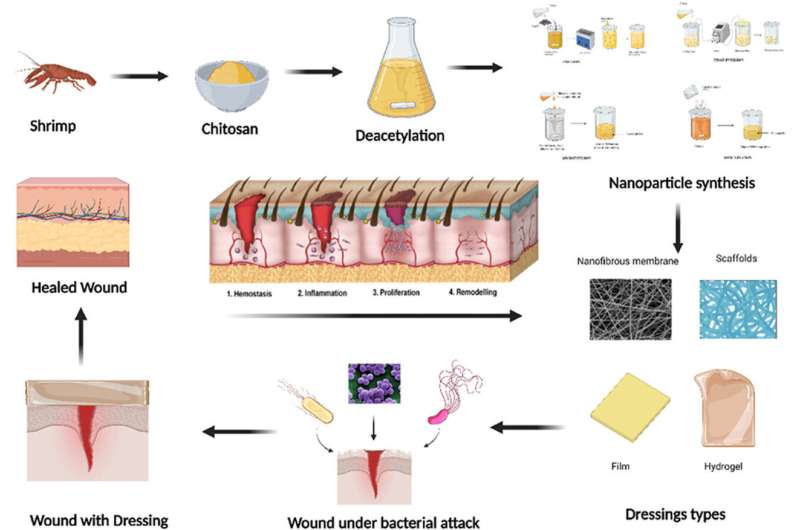This article has been reviewed according to Science X's editorial process and policies. Editors have highlighted the following attributes while ensuring the content's credibility:
fact-checked
peer-reviewed publication
trusted source
proofread
Advancements in sustainable chitosan-based nanocomposites for wound dressings

Deepak Verma from Chulalongkorn University and his international team of researchers are exploring ways to enhance chitosan using techniques like adding photosensitizers, dendrimers, and chemical modifications. They also surveyed the use of chitosan nanoparticles for medical purposes, notably wound dressings.
Functionalized chitosan nanocomposites have garnered significant attention within the realm of wound dressing applications due to their remarkable antibacterial and antifungal properties. The inherent qualities of polysaccharides, including potent antibacterial attributes and controlled drug release capabilities, make them a promising avenue for facilitating wound healing processes.
Motivated by the need to deliver against the UNSDGs, the adoption of eco-friendly principles in the creation of green materials for wound healing is crucial. Nonetheless, accomplishing this goal necessitates a transformative, step-change approach.
To this end, Verma and his team have conducted a comprehensive survey of diverse methodologies for functionalizing chitosan. These methods encompass a spectrum of techniques, such as incorporating photosensitizers, utilizing dendrimers, graft copolymerization, quaternization, acylation, carboxyalkylation, phosphorylation, sulfation, and thiolation.
Moreover, the current survey explores the insights regarding the processing of chitosan nanoparticles for biomedical applications, specifically emphasizing their relevance in the context of wound dressings.
Verma and his team have also explored the strategies employed in chitosan nanoparticle preparation. The main interest is the potential of these nanoparticles for wound dressings, given their capacity for targeted and controlled release of therapeutic agents.
Looking ahead, the survey speculates on the new challenges lying in the landscape of chitosan research. These include the challenge of chronic wounds that take a long time to heal, devising effective wound healing interventions tailored to diabetic wounds and venous leg ulcers, refining current understanding of the intricate wound healing mechanisms facilitated by such materials, and ultimately, offering enhanced treatment alternatives that optimize the wound healing process.
This survey has been published in Environmental Research. It will be of great interest to researchers who are keen to apply an eco-friendly approach to developing wound healing dressing, policymakers who are regulating eco-friendly medical products and professionals working in the medical device technology industry.
More information: Deepak Verma et al, Sustainable functionalized chitosan based nano-composites for wound dressings applications: A review, Environmental Research (2023). DOI: 10.1016/j.envres.2023.116580
Journal information: Environmental Research
Provided by Newcastle University in Singapore




















